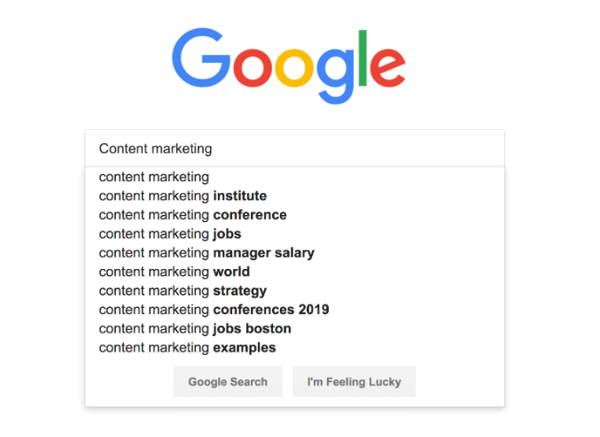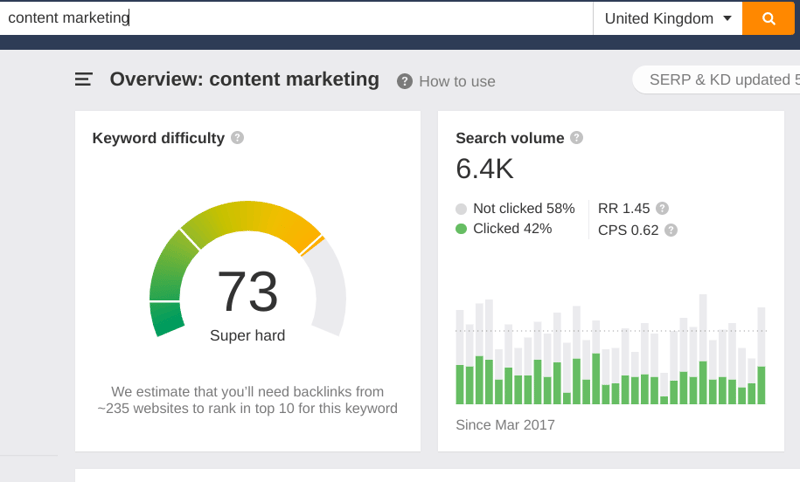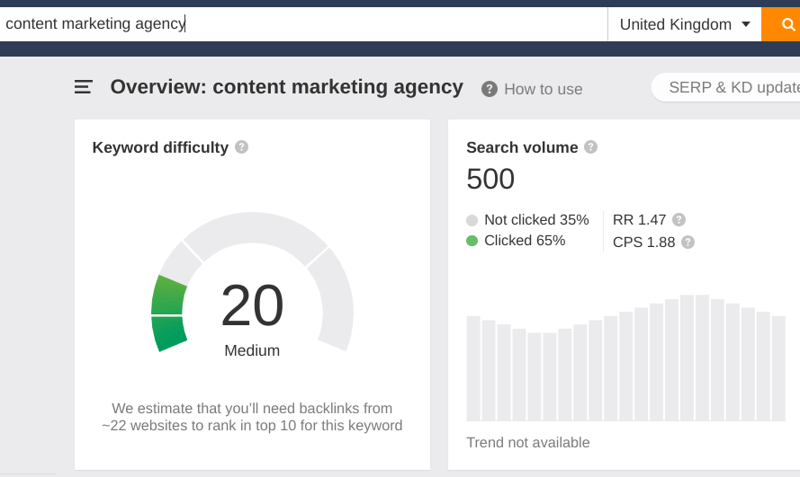One of the most effective ways to grow your business is through search engine optimisation (SEO), the process of getting traffic from the “free,” “organic,” “editorial” or “natural” search results on search engines.
Having a good SEO strategy in place is essential for organisations to thrive online today, but many businesses are still wary of it. Often, SEO is made to sound more complex than it actually is, and we want to combat this. So, we’re starting at the beginning with keyword research.
We’ve created a simple and easy-to-follow, step-by-step guide to keyword research for beginners, detailing everything you need to do to get your business seen by search engines - without any of the complicated language.
Step 1: Set your overall goals
Before you begin keyword research, you need to devote some time to figuring out what your SEO goals are. Many companies use SEO primarily for an increase in website traffic and an increase in leads generated as a result; however, you will need to be more specific about what you’re trying to achieve and more importantly, how you’re going to do it. Take time to determine:
How quickly you need to see positive results.
SEO is not a short-term solution, it is a long-term strategy that can often take months before results become apparent. If you want quicker results, you will need to use keywords with lower competition and higher search volume; but we recommend sticking it out for the long haul for better, sustainable results.
Who your audience is.
Think about how specific your target audience is: are you focusing on one type of individual, or can you be more flexible? To help you figure this out, create buyer personas that include key customer information such as behavior patterns, motivations and goals. The more detailed you are with this, the more effective your keyword research will be.
The kind of traffic you need.
If you want an increase in organic traffic, this would require a different keyword strategy than if you wanted to increase your brand awareness. Being specific here is key - including clearly defined SMART goals will help you track your progress and determine if your strategy is successful.
Once you have set and fully understood your goals, you can begin keyword research - starting with narrowing down the topics you want to focus on.
Step 2: List topics related to your business
At this stage, don’t worry about narrowing down keywords, simply make a list of what you believe to be important, relevant topics related to your business. Try and come up with about 5-10 core topics that you think are key to your business and target audience, and these will form the basis of your research.
Here’s an example list we made for our own keyword research:
- Content marketing
- Inbound marketing
- Website design
- Lead generation
As you can see, we chose topics based on what is relevant to our business, as well as what our target audience is actually searching for.
This is extremely important: be sure to put yourselves in the shoes of your buyer personas. Many businesses make the mistake of creating topics around what they want their customers to be searching for, not what they’re actually searching for - don’t do this. Be honest about what you think your target audience is searching for, because your topics (and keywords) are likely to be more realistic and successful.
Step 3: Gather keyword ideas
Once you have a list of topics narrowed down, you are ready to begin researching potential keywords. As a start, you can use Google’s “searches related to”, which refers to the automated suggestions search engines provide during searches, and it looks something like this:

The words in bold are what you need to make use of, because these are what people typically search for in addition to the target keyword. Be sure to include any relevant keywords that appear and write them down in a list. Don’t forget to include long tail keywords either. These are three (or more) word phrases which are very specific to your topic, and they can be good to try and rank for, especially for B2B organisations with specialised products or services.
By doing this, you can gather keyword ideas that are closely related to your chosen topics, and make the process of narrowing down topics into keywords much easier. You can also look on YouTube, Reddit and other sites for more thorough research.
On top of this, you need to search for LSI (Latent semantic indexing) keywords. These are words and phrases that correlate with your target topic - but aren’t the target keyword. Google has always been focused on connecting users with great quality content, and its algorithm uses LSI keywords as a way of determining this - which is especially relevant to recent updates that focus on connecting users with the answers they want, not just the words they’re searching for.
For example, if you want to rank for “how to start a blog”, use keywords like “starting a blog” or “how to launch a blog” throughout your content to establish it as higher quality and avoid keyword stuffing. You can do this by using a tool such as LSI Graph, which will provide you with synonyms of the target keyword that you can use in order to rank higher in the search engines.
Remember: While LSI keywords don’t generally form part of your main SEO strategy, they should always be used when you are producing content.
Step 4: Eliminate keywords with high difficulty
Once you’ve collected a list of potential keywords, it's time to start narrowing them down by removing any that you’re unlikely to be able to rank for.
How can you do this?
We recommend using an SEO tool such as ahrefs; use their keyword explorer to determine keyword difficulty compared with search volume to help decide which keywords are worth keeping in your list. Using the tool, you can eliminate keywords that are too hard to rank for, or keywords that just aren’t being searched enough. Below is an example from ahrefs:

Here, we can see that “content marketing” alone is not a good keyword, as it is far too difficult to rank for and has an extremely high search volume. Once you know this, you can begin creating long tail keywords based on the original keyword that are much more viable to rank for.

Here, we can see that “content marketing agency” is a much better keyword to rank for: it isn’t as difficult, but still has a large search volume - meaning that we would have a much better chance of ranking highly for this keyword should we make it part of our strategy.
As you repeat this process, you will begin to develop a list of new keywords (both short and long) that you have the potential to rank highly for. Then, you need to look at your business’ current place in the search engines, in order to determine how much work you need to do to start climbing the ranks.
Step 5: Check your own and competitors’ keywords
As well as eliminating keywords that are too difficult to rank for, you need to check what position your business currently holds in Google for all of your chosen keywords. On top of this, check what your competitors are ranking for; this way, if there are any keywords missing from your own strategy, you can add them to your list, gain further understanding of what the most targeted phrases are in your industry and identify gaps in your competitors’ strategy.
By knowing what’s working for your competitors, you can determine exactly what you should be doing to improve your own rankings. It also saves a great deal of time and resources spent on trying to come up with new keywords all on your own. To investigate how well your competitors are doing, you can use tools such as SEMrush or ahrefs to look at domain authority, overall website traffic and the most commonly used keywords.
Once you’ve done this, we recommend exporting all of the relevant competitor keywords into a spreadsheet that can be accessed when creating content and used to inform your SEO strategy as a whole.
Step 6: Create topic clusters
Once you have a finalised list of target keywords, you should start organising these into ‘topic clusters’. These allow you to group together multiple long tail keywords around core topics (do bear in mind that these could be slightly different to your original topics established in step 1).
When you have chosen your core topics, you can begin planning content covering the target keywords, and developing “cluster content” that links to them. The benefit of using topic clusters is that instead of targeting a number of random keywords, it allows you to focus on a specific topic that you can then create strong, interlinked content for. This model allows your business to become recognisable as an expert, or thought leader a specific topic.
You can create topic clusters in a tool such as HubSpot, where they look like this:

Without topic clusters, blogs end up competing for the same keywords and risk cannibalising content (shock: Google doesn’t appreciate this either). However, when you use the topic cluster model, you are able to focus on broader topics instead of just long-tail keywords, which increases your chances of becoming an authority on your chosen topic because all of your content is connected.
Not only this, but topic clusters organise your content in a way that allows your target audience to find the answers they want quickly and easily and increases the chance of being ranked highly by the search engines, which ultimately results in an increase in traffic and leads.
Choosing keywords is just one component of your overall SEO strategy (and it's just one part of your wider approach to attracting visitors to your B2B website) but it's an important one. If you aren’t thorough in your keyword research, you risk targeting the wrong topics in all of your content - so you need to devote significant time and resources to this part of your SEO strategy.
If you’re ready for the next stage of developing your overall SEO strategy, take a look at our helpful all-encompassing resource: The Ultimate Guide to SEO. This extremely thorough guide covers everything from building an SEO strategy and link building to monitoring your progress, to help you craft an effective strategy with noticeable results.






.png?width=115&height=183&name=sade%201%20(1).png)